Are you a fountain of knowledge about water?
Although water covers about 70 per cent of planet Earth’s surface, less than one per cent is available as fresh water for use to drink and cook with. Most of our planet’s water is in the ocean, but seawater is too salty to drink and can’t be used for other things, like water plants. But even the one per cent that is freshwater isn’t water we can use. Most of it – about two-thirds- is frozen on the tops of mountains or at the North and South Poles. So for all the people on Earth – that’s seven billion people – there’s only a tiny fraction of all the water on Earth for them to use. The drinking water in Barbados comes from groundwater. Groundwater is water underground in natural water chambers, called aquifers. Rainwater trickles through soil, sand and our coral limestone and into the aquifers. The groundwater can then be pumped through wells or is found as springs.
Groundwater is water that exists below the land surface and fills the spaces between soil and crevices in rocks, into natural underground caves filled with water which, as we learned before, are called aquifers.
Most of the time, the rain that falls moves slowly through the spaces in soils and rocks, known as pores, and trickles down into the aquifer. The water’s journey to the aquifer is slow – just a few metres per year. In Barbados, it can take anywhere from three to four months for today’s rain to reach the aquifer. Much of it goes to plants, or evaporates and returns to the sky before it can reach the aquifer or, in a heavy downpour, flows out to sea.
We actually benefit from this long, slow trickle of rainwater to the aquifer. It purifies the water a great deal. The limestone rock acts like a giant strainer or filter of all the mud and other debris, so that muddy puddles of water become crisp, clear streams that eventually fill our aquifers. Our groundwater is so clean that we only treat the water with tiny amounts of a chemical called chlorine which kills any harmful germs that might be in the water. If you ever visit Harrison Cave, you will see how the murky brown rainwater that sloshes along the gutter and into wells is filtered by the limestone into the fresh, cold groundwater that flows throughout the cave.
Rain filters through the soil and rock as it becomes the main source of groundwater. Much of the water going to the soil is used by plants. Some water remains in the soil, while the rest moves downward to the aquifer. An aquifer isn’t necessarily the final stop for the rain that fell from the sky months before. All the pores of the aquifer have to be so full of groundwater, or saturated, before the rest can continue its slow underground journey back to the ocean. However, if we pump too much freshwater from the aquifer too soon, the ground water could become salty, as seawater rushes back through the rock, which could ruin the aquifer.
